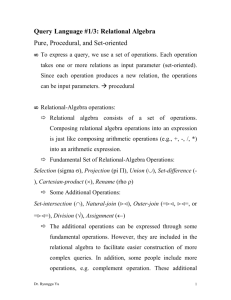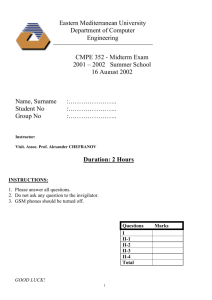One-Pass Algorithms
advertisement
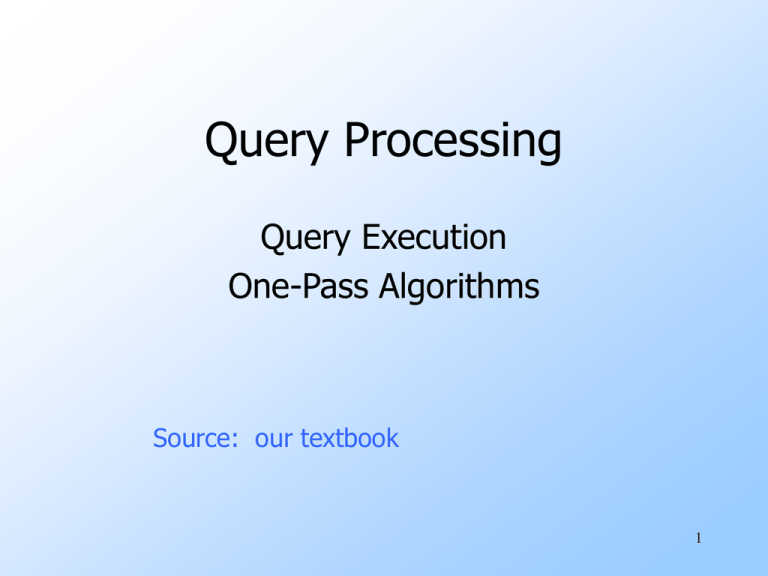
Query Processing Query Execution One-Pass Algorithms Source: our textbook 1 Overview of Query Processing SQL query parse query query expression tree Query Compilation (Ch 16) metadata select logical query plan logical query plan tree Query Optimization select physical query plan physical query plan tree execute physical query plan data Query Execution (Ch 15) 2 Overview of Query Compilation convert SQL query into a parse tree convert parse tree into a logical query plan convert logical query plan into a physical query plan: choose algorithms to implement each operator of the logical plan choose order of execution of the operators decide how data will be passed between operations Choices depend on metadata: size of the relations approximate number and frequency of different values for attributes existence of indexes data layout on disk 3 Overview of Query Execution Operations (steps) of query plan are represented using relational algebra (with bag semantics) Describe efficient algorithms to implement the relational algebra operations Major approaches are scanning, hashing, sorting and indexing Algorithms differ depending on how much main memory is available 4 Relational Algebra Summary Set operations: union U, intersection , difference – projection, PI, (choose columns/atts) selection, SIGMA, (choose rows/tuples) Cartesian product X natural join (bowtie, ) : pair only those tuples that agree in the designated attributes renaming, RHO, duplicate elimination, DELTA, grouping and aggregation, GAMMA, sorting, TAU, 5 Measuring Costs Parameters: M : number of main-memory buffers available (size of buffer = size of disk block). Only count space needed for input and intermediate results, not output! For relation R: • B(R) or just B: number of blocks to store R • T(R) or just T: number of tuples in R • V(R,a) : number of distinct values for attribute a appearing in R Quantity being measured: number of disk I/Os. Assume inputs are on disk but output is not written to disk. 6 Scan Primitive Reads entire contents of relation R Needed for doing join, union, etc. To find all tuples of R: Table scan: if addresses of blocks containing R are known and contiguous, easy to retrieve the tuples Index scan: if there is an index on any attribute of R, use it to retrieve the tuples 7 Costs of Scan Operators Table scan: if R is clustered, then number of disk I/Os is approx. B(R). if R is not clustered, number of disk I/Os could be as large as T(R). Index scan: approx. same as for table scan, since the number of disk I/Os to examine entire index is usually much much smaller than B(R). 8 Sort-Scan Primitive Produces tuples of R in sorted order w.r.t. attribute a Needed for sorting operator as well as helping in other algorithms Approaches: 1. If there is an index on a or if R is stored in sorted order of a, then use index or table scan. 2. If R fits in main memory, retrieve all tuples with table or index scan and then sort 3. Otherwise can use a secondary storage sorting algorithm (cf. Section 11.4.3) 9 Costs of Sort-Scan See earlier slide for costs of table and index scans in case of clustered and unclustered files Cost of secondary sorting algorithm is: approx. 3B disk I/Os if R is clustered approx. T + 2B disk I/Os if R is not 10 Categorizing Algorithms By general technique sorting-based hash-based index-based By the number of times data is read from disk one-pass two-pass multi-pass (more than 2) By what the operators work on tuple-at-a-time, unary full-relation, unary full-relation, binary 11 One-Pass, Tuple-at-a-Time These are for SELECT and PROJECT Algorithm: read the blocks of R sequentially into an input buffer perform the operation move the selected/projected tuples to an output buffer Requires only M ≥ 1 I/O cost is that of a scan (either B or T, depending on if R is clustered or not) Exception! Selecting tuples that satisfy some condition on an indexed attribute can be done faster! 12 One-Pass, Unary, Full-Relation duplicate elimination (DELTA) Algorithm: keep a main memory search data structure D (use search tree or hash table) to store one copy of each tuple read in each block of R one at a time (use scan) for each tuple check if it appears in D if not then add it to D and to the output buffer Requires 1 buffer to hold current block of R; remaining M-1 buffers must be able to hold D I/O cost is just that of the scan 13 One Pass, Unary, Full-Relation grouping (GAMMA) Algorithm: keep a main memory search structure D with one entry for each group containing • values of grouping attributes • accumulated values for the aggregations scan tuples of R, one block at a time for each tuple, update accumulated values • • • • MIN/MAX: keep track of smallest/largest seen so far COUNT: increment by 1 SUM: add value to accumulated sum AVG: keep sum and count; at the end, divide write result tuple for each group to output buffer 14 Costs of Grouping Algorithm No generic bound on main memory required: group entries could be larger than tuples number of groups can be anything up to T but typically group entries are not longer than tuples many fewer groups than tuples Disk I/O cost is that of the scan 15 One Pass, Binary Operations Bag union: copy every tuple of R to the output, then copy every tuple of S to the output only needs M ≥ 1 disk I/O cost is B(R) + B(S) For set union, set intersection, set difference, bag intersection, bag difference, product, and natural join: read smaller relation into main memory use main memory search structure D to allow tuples to be inserted and found quickly needs approx. min(B(R),B(S)) buffers disk I/O cost is B(R ) + B(S) 16 Set Union (R U S) Assume S fits in M-1 main memory buffers read S into main memory for each tuple of S insert it into a search structure D (key is entire tuple) copy it to output read each block of R into 1 buffer one at a time for each tuple of R if it is not in D (i.e., not in S) then copy to output 17 Set Intersection (R S) Assume S fits in M-1 main memory buffers read S into main memory for each tuple of S insert it into a search structure D (key is entire tuple) read each block of R into 1 buffer one at a time for each tuple of R if it is in D (i.e., in S) then copy to output 18 Set Difference (R - S) Assume S fits in M-1 main memory buffers read S into main memory for each tuple of S insert into a search structure D (key is entire tuple) read each block of R into 1 buffer one at a time for each tuple of R if it is not in D (i.e., not in S) then copy to output 19 Additional Binary Operations See text for one-pass algorithms for S - R bag intersection bag difference product Similar to the previous algorithms Require that one of the operands fit in main memory 20 One Pass, Natural Join Assume R(X,Y) is to be joined with S(Y,Z) and S fits in M-1 main memory buffers read S into main memory for each tuple of S insert into a search structure D (key is atts in Y) read each block of R into 1 buffer one at a time for each tuple t of R use D to find all tuples of S that agree with t on atts Y for each matching tuple u of S, concatenate t and u and copy to output 21 What Ifs? What if data is not clustered? Then it takes T(R) disk I/Os instead of B(R) to read all the tuples of R But any relation that is the result of an operator will be stored clustered What if M is unknown/wrongly estimated? If over-estimated, then one-pass algorithm will be very slow due to thrashing between disk and main memory If under-estimated and a two-pass algorithm is used when a one-pass would have sufficed, unnecessary disk I/Os are done 22

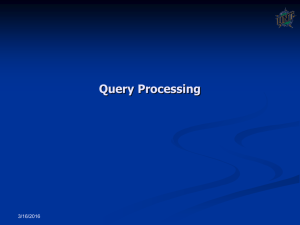
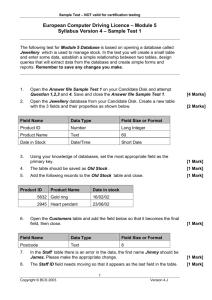
![Charul_Saxena_ID_201_Lecture_Notes[1]](http://s2.studylib.net/store/data/005640284_1-b2650585c899027ad372bbf133657f58-300x300.png)
